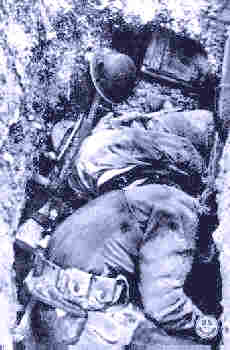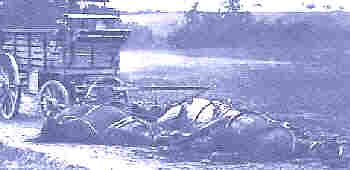BURIAL OF THE DEAD
An AEF Original Document
AMERICAN EXPEDITIONARY FORCESFrance.October 21, 1918
From: Chief Surgeon, First Army Corps, American E.F.  Dead Doughboy of the 38th InfantryDuring active open operations burial of the dead becomes a sanitary matter of the greatest importance. During the Chateau-Thierry campaign many bodies of men and animals lay on the battlefield for days after their death. During the warm weather prevailing then, they soon decomposed and formed most unsightly and insanitary objects. The stench was terrific but the worst feature was that of fly breeding. The bodies of both men and horses soon become a mass of maggots and flies bred by millions - the surrounding country was infested with them. The result was a widespread outbreak of enteric disease that fortunately carried with it no mortality. Men were usually sick only a few days and were not seriously ill. A few however showed blood and mucus in the stools and were real dysentary. Bacteriologically, Flexner and Shiga bacilli were isolated as well as paratyphoid. It is therefore apparent that a serious outbreak of real dysentary was narrowly averted. It is not certain that flies were responsible for this outbreak but the presumptive evidence is strong. 2. It at once became evident that some systematic method of solving this problem must be adopted The writer felt very strongly that combatant troops should not be called upon for this work for several reasons: (a) From a sanitary viewpoint, burials should be accomplished promptly. Fighting troops cannot be removed from the line for this purpose. (b) After an engagement, combatant troops are exhausted and should not be called upon to perform manual labor, at least until they have been thoroughly rested. (c) The effect upon the morale of combatant troops of being compelled to bury their own dead is very bad. During conditions such as they were at Chateau-Thierry when the bodies soon became black, swollen, discolored remnants of humanity, literarily covered with maggots, the effect is of course tremendously bad. (d) If left to combat troops, each division will have its own method or no method at all and the results are bound to be unsatisfactory 3. Upon the recommendation of the Corps Surgeon, the following plan was adopted by the 1st Army Corps. One company of Pioneer Infantry (Corps Troops) is assigned to each division and is placed under the control of the Division Sanitary Inspector. They are to be used for no other purpose than burial of the dead - men and animals. They follow up the advancing combatant troops as closely as possible and bury the dead as they find them. They are supplied with picks and shovels and rationed with the division. Bodies of men are collected whenever possible into groups and buried together in selected spots.  Dead HorsesAnimals are buried wherever it is most convenient - as near where they fall as may be in order to avoid dragging them any distance. Chaplains of the division are charged with all other details except the actual burying. They collect personal belongings, hold whatever services are possible and in conjunction with the Graves Registration Service, assure proper identification. The plan has worked admirably and the present battlefield is in great contrast in this respect to those preceding. No dead bodies can be found until one reaches the very advanced areas where the Pioneer troops have not yet arrived. The labor in burying a number of dead horses is enormous, and with heavy casualties of both men and animals, one company to a division is not sufficient. 4. This detail is also utilized in filling old latrines and doing other necessary work as they pass along the area. 5. It is believed that probably better administration could be secured by placing all the companies of Pioneers that are available for this work under the control of the Corps Sanitary Inspector. He can then distribute them and change them as circumstances require. 6. It is repeated that this is a most important sanitary problem that has been very satisfactorily solved in this Corps by the above plan.  Burial DetailJ.W. GRISSINGER Colonel, Medical Corps, U.S.A. |
To find other Doughboy Features visit our |
Membership Information  Click on Icon |
For further information on the events of 1914-1918
visit the homepage of |
Michael E. Hanlon (medwardh@hotmail.com) regarding content,
or toMike Iavarone (mikei01@execpc.com) regarding form and function.
Original artwork & copy; © 1998-2000, The Great War Society